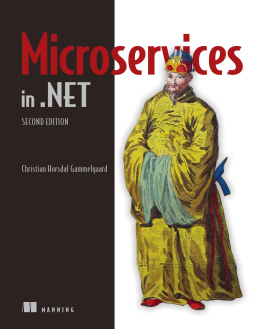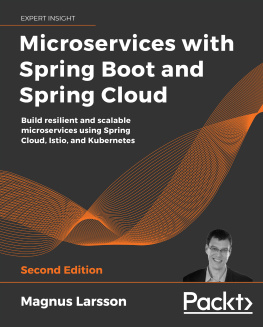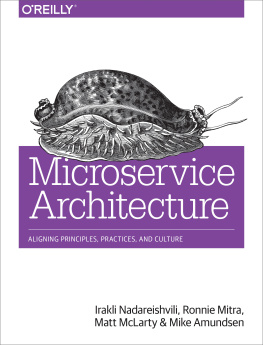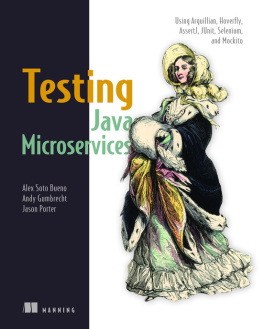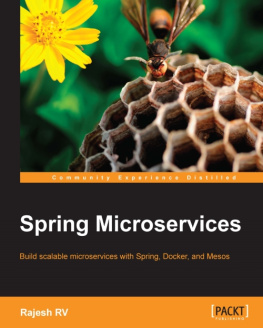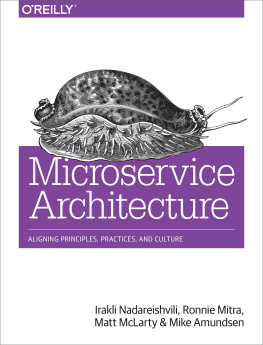Eberhard Wolff - Microservices: Flexible Software Architecture
Here you can read online Eberhard Wolff - Microservices: Flexible Software Architecture full text of the book (entire story) in english for free. Download pdf and epub, get meaning, cover and reviews about this ebook. year: 2016, publisher: Addison-Wesley Professional, genre: Computer. Description of the work, (preface) as well as reviews are available. Best literature library LitArk.com created for fans of good reading and offers a wide selection of genres:
Romance novel
Science fiction
Adventure
Detective
Science
History
Home and family
Prose
Art
Politics
Computer
Non-fiction
Religion
Business
Children
Humor
Choose a favorite category and find really read worthwhile books. Enjoy immersion in the world of imagination, feel the emotions of the characters or learn something new for yourself, make an fascinating discovery.

- Book:Microservices: Flexible Software Architecture
- Author:
- Publisher:Addison-Wesley Professional
- Genre:
- Year:2016
- Rating:3 / 5
- Favourites:Add to favourites
- Your mark:
Microservices: Flexible Software Architecture: summary, description and annotation
We offer to read an annotation, description, summary or preface (depends on what the author of the book "Microservices: Flexible Software Architecture" wrote himself). If you haven't found the necessary information about the book — write in the comments, we will try to find it.
The Most Complete, Practical, and Actionable Guide to Microservices
Going beyond mere theory and marketing hype, Eberhard Wolff presents all the knowledge you need to capture the full benefits of this emerging paradigm. He illuminates microservice concepts, architectures, and scenarios from a technology-neutral standpoint, and demonstrates how to implement them with todays leading technologies such as Docker, Java, Spring Boot, the Netflix stack, and Spring Cloud.
The author fully explains the benefits and tradeoffs associated with microservices, and guides you through the entire project lifecycle: development, testing, deployment, operations, and more. Youll find best practices for architecting microservice-based systems, individual microservices, and nanoservices, each illuminated with pragmatic examples. The author supplements opinions based on his experience with concise essays from other experts, enriching your understanding and illuminating areas where experts disagree. Readers are challenged to
experiment on their own the concepts explained in the book to gain hands-on experience.
- Discover what microservices are, and how they differ from other forms of
- modularization
- Modernize legacy applications and efficiently build new systems
- Drive more value from continuous delivery with microservices
- Learn how microservices differ from SOA
- Optimize the microservices project lifecycle
- Plan, visualize, manage, and evolve architecture
- Integrate and communicate among microservices
- Apply advanced architectural techniques, including CQRS and Event Sourcing
- Maximize resilience and stability
- Operate and monitor microservices in production
- Build a full implementation with Docker, Java, Spring Boot, the Netflix stack, and Spring Cloud
- Explore nanoservices with Amazon Lambda, OSGi, Java EE, Vert.x, Erlang, and Seneca
- Understand microservices impact on teams, technical leaders, product owners, and stakeholders
Managers will discover better ways to support microservices, and learn how adopting the method affects the entire organization. Developers will master the technical skills and concepts they need to be effective. Architects will gain a deep understanding of key issues in creating or migrating toward microservices, and exactly what it will take to transform their plans into reality.
Eberhard Wolff: author's other books
Who wrote Microservices: Flexible Software Architecture? Find out the surname, the name of the author of the book and a list of all author's works by series.



